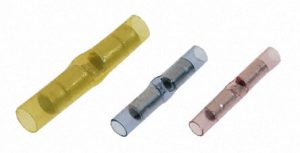
Butt splice connectors offer a simple way to join two wires. They consist of crimp-style sleeves with a conductive interior. After stripping the ends of two wires, you can insert them into a butt splice connector. Crimping will compress the wires so that they stay inside of the butt splice connector.
Construction
Different butt splice connectors feature a different construction. There are Pre-insulated Diamond Grip (PDIG) butt splice connectors, for instance. Like all butt splice connectors, PDIG consists of a crimp-style sleeve with a conductive interior. PDIG is a design specification, though, that includes a copper sleeve.
When crimping a PDIG butt sleeve connector, the copper sleeve will collapse onto the wires. PDIG butt splice connectors have a copper sleeve. Copper, of course, is conductive, so it’s able to promote a stronger and more reliable circuit connection.
Size
You can’t choose butt splice connectors without considering the size. Butt splice connectors are available in different sizes. The size of a butt splice connector will determine the size of the wire with which it can be used.
Most butt splice connectors support a narrow range of American Wire Gauge (AWG) sizes. They aren’t limited to any single AWG size. Rather, you can use butt splice connectors for multiple AWG sizes, such as 18 to 22 AWG. Regardless, you’ll need to choose butt splice connectors in an AWG range that’s appropriate for the wires with which you intend to use.
Heat Shrink
Some butt splice connectors support heat shrinking. Known as heat shrink butt splice connectors, they offer a supplementary connection method. Most heat butt splice connectors still support crimpling. Before crimping them, though, you can heat shrink them.
Heat shrinking involves the use of a heat gun to fuse the ends of a wire with the interior of a connector. The connector will essentially wrap around the wire. While some butt splice connectors only support crimping, others support crimping and heat shrinking.
Insulation
You should consider the insulation when choosing butt splice connectors. All butt splice connectors have insulation. Insulation is the nonconductive material on the outside of a connector.
Some butt splice connectors have vinyl insulation, whereas others have nylon insulation. They are both effective materials for insulation. Nylon, though, offers a higher level of heat resistance than vinyl. If you’re planning to use the butt splice connectors in a hot environment, you may want to choose connectors with nylon insulation.



